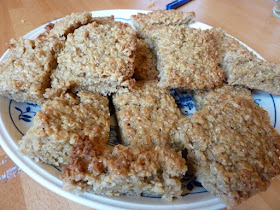We all went to a Chinese/Japanese noodle place the other day, and Carmela was very disappointed when the duck she ordered didn't come shredded and served with pancakes, so I promised to remedy this at the earliest opportunity. Yesterday we went to the
Edinburgh Farmer's Market and picked up a whole duck from
Gartmorn Farm. Apparently making authentic Peking duck is a complicated process, involving scalding, pumping air between skin and flesh, and air-drying over several days, among other things, so I settled for a slightly simpler (and quicker)
steam-and-roast routine.
Ingredients
1 large duck (2.5 to 3 kg)
dry marinade
1 tbsp five spice powder
2 tsps demerara sugar
2 tsps salt
stuffing
peel of 1 orange, sliced
6 thick slices of fresh ginger
6 spring onions, peeled and chopped into 2cm lengths
4 cloves of garlic, peeled and sliced
basting sauce
50 ml rice vinegar
100 ml clear honey
100 ml dark soy sauce
Method
- Mix the dry marinade ingredients together. Dry the duck thoroughly with paper towel, and pat the marinade all over the outside and inside of the duck. (You can do this the day before if you are feeling leisurely.)
- Mix the stuffing ingredients and insert into the cavity of the duck.
- Place the duck on a V-rack in a roasting tin, pour a little boiling water into the bottom of the tin, and cover the whole assemblage with tinfoil (sealing to make sure it is reasonably steamproof), Place the tin on top of the stove, on a gentle heat, and steam for 45 minutes. Check the water level from time to time, and top up if required.
- Set the oven to 200oC.
- Meanwhile, mix the basting sauce ingredients in a small saucepan, bring to a boil, reduce heat to minimum and simmer gently for about 10 minutes until the sauce thickens.
- Once the duck has finished steaming, remove the foil from the top, baste generously, and transfer to the preheated oven.
- Bake for 1 hour, basting every 20 minutes.
- When the duck is cooked, remove from oven and allow to rest for 5 minutes. Carve and serve with Chinese pancakes, spring onions, cucumber sticks, and plum sauce.

Ducks and dogs
We also took our labrador, Ronia, to the farmer's market, where she was petted by all and sundry, and ate out royally on fried onions (at the burger stand), some bits of pork crackling (from the hog roast), a stray sausage, and a pork bone. The next day we went to Cramond, where she promptly dived into the water in pursuit of some fresh duck. She came back empty-mouthed, but I decided to give her the neck and giblets from this one as compensation.








